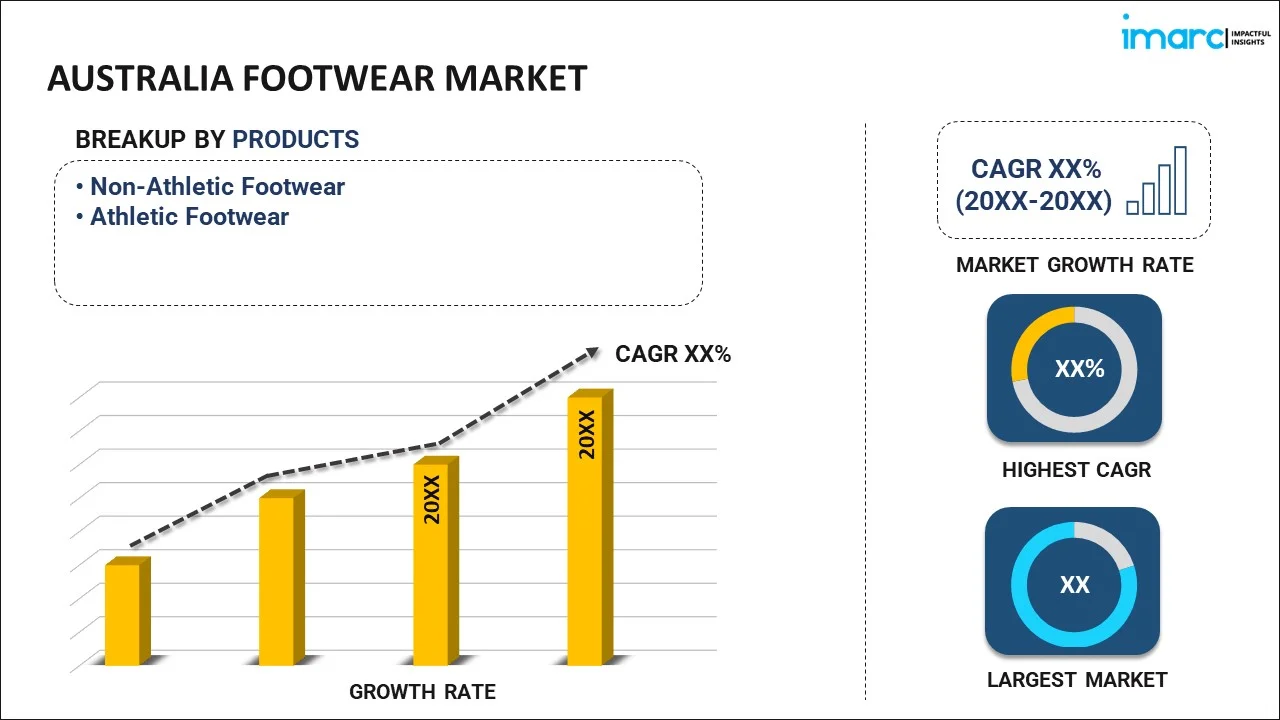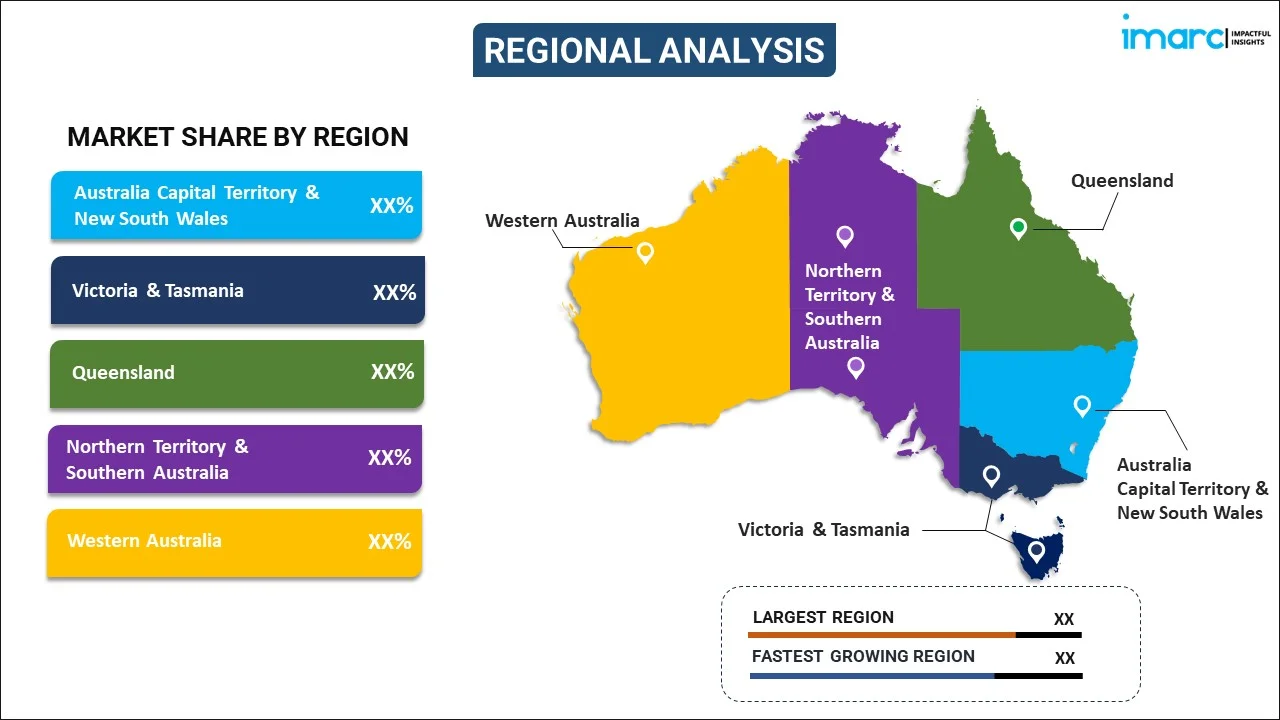
Australia Footwear Market Report by Product (Non-Athletic Footwear, Athletic Footwear), Material (Rubber, Leather, Plastic, Fabric, and Others), Distribution Channel (Footwear Specialists, Supermarkets and Hypermarkets, Departmental Stores, Clothing Stores, Online Sales, and Others), Pricing (Premium, Mass), End User (Men, Women, Kids), and Region 2025-2033
Market Overview:
Australia footwear market size is projected to exhibit a growth rate (CAGR) of 6.27% during 2025-2033. The rising penetration of e-commerce retail platforms and the introduction of advanced technical fabrications, which provide maximum comfort to individuals, are primarily driving the market growth across the country.
|
Report Attribute
|
Key Statistics
|
|---|---|
|
Base Year
|
2024 |
|
Forecast Years
|
2025-2033 |
|
Historical Years
|
2019-2024
|
| Market Growth Rate (2025-2033) | 6.27% |
Footwear is specifically designed to be worn on the feet for protection, comfort, and fashion. It encompasses a wide range of styles, including shoes, sandals, boots, etc. These items are crafted from various materials such as leather, canvas, rubber, synthetic fabrics, etc. Footwear has evolved from simple, utilitarian designs to encompass intricate styles that reflect cultural, social, and fashion trends. Beyond offering protection from the elements, footwear has become a symbol of personal expression and style. Modern footwear serves both functional and aesthetic purposes, with designs ranging from casual to formal, and from athletic performance to high fashion.
Australia Footwear Market Trends:
The Australia footwear market is experiencing significant growth, driven by a combination of pivotal factors. Primarily, the evolving fashion landscape and changing consumer preferences are significant drivers, influencing individuals across the country to adopt a diverse range of footwear styles. Besides this, the widespread utilization of versatile designs reflects the fusion of functionality and aesthetic appeal, thereby positively influencing the market growth in Australia. Furthermore, the increasing emphasis on health and wellness is shaping the market dynamics. Apart from this, consumers are prioritizing comfort and ergonomics, leading to the rising demand for footwear featuring advanced technologies and materials that promote foot health. Additionally, e-commerce platforms play a crucial role in the market's expansion. The convenience of online shopping, along with an extensive variety of brands and styles, resonates with consumers, driving the digitalization of the footwear retail landscape. Moreover, strategic collaborations between footwear brands and celebrities or influencers significantly impact individual choices. In line with this, endorsements and partnerships enhance brand visibility and create a narrative that resonates with the target audience, shaping purchasing decisions. In conclusion, the evolving fashion industry, the elevating health consciousness, the emerging e-commerce trends, and strategic marketing initiatives are anticipated to fuel the Australia footwear market over the forecasted period.
Australia Footwear Market Segmentation:
IMARC Group provides an analysis of the key trends in each segment of the market, along with forecasts at the country level for 2025-2033. Our report has categorized the market based on product, material, distribution channel, pricing, and end user.
Product Insights:

- Non-Athletic Footwear
- Athletic Footwear
The report has provided a detailed breakup and analysis of the market based on the product. This includes non-athletic footwear and athletic footwear.
Material Insights:
- Rubber
- Leather
- Plastic
- Fabric
- Others
A detailed breakup and analysis of the market based on the material have also been provided in the report. This includes rubber, leather, plastic, fabric, and others.
Distribution Channel Insights:
- Footwear Specialists
- Supermarkets and Hypermarkets
- Departmental Stores
- Clothing Stores
- Online Sales
- Others
The report has provided a detailed breakup and analysis of the market based on the distribution channel. This includes footwear specialists, supermarkets and hypermarkets, departmental stores, clothing stores, online sales, and others.
Pricing Insights:
- Premium
- Mass
A detailed breakup and analysis of the market based on the pricing have also been provided in the report. This includes premium and mass.
End User Insights:
- Men
- Women
- Kids
The report has provided a detailed breakup and analysis of the market based on the end user. This includes men, women, and kids.
Regional Insights:

- Australia Capital Territory & New South Wales
- Victoria & Tasmania
- Queensland
- Northern Territory & Southern Australia
- Western Australia
The report has also provided a comprehensive analysis of all the major regional markets, which include Australia Capital Territory & New South Wales, Victoria & Tasmania, Queensland, Northern Territory & Southern Australia, and Western Australia.
Competitive Landscape:
The market research report has also provided a comprehensive analysis of the competitive landscape. Competitive analysis such as market structure, key player positioning, top winning strategies, competitive dashboard, and company evaluation quadrant has been covered in the report. Also, detailed profiles of all major companies have been provided.
Australia Footwear Market Report Coverage:
| Report Features | Details |
|---|---|
| Base Year of the Analysis | 2024 |
| Historical Period | 2019-2024 |
| Forecast Period | 2025-2033 |
| Units | Million USD |
| Scope of the Report | Exploration of Historical Trends and Market Outlook, Industry Catalysts and Challenges, Segment-Wise Historical and Future Market Assessment:
|
| Products Covered | Non-Athletic Footwear, Athletic Footwear |
| Materials Covered | Rubber, Leather, Plastic, Fabric, Others |
| Distribution Channels Covered | Footwear Specialists, Supermarkets and Hypermarkets, Departmental Stores, Clothing Stores, Online Sales, Others |
| Pricings Covered | Premium, Mass |
| End Users Covered | Men, Women, Kids |
| Regions Covered | Australia Capital Territory & New South Wales, Victoria & Tasmania, Queensland, Northern Territory & Southern Australia, Western Australia |
| Customization Scope | 10% Free Customization |
| Post-Sale Analyst Support | 10-12 Weeks |
| Delivery Format | PDF and Excel through Email (We can also provide the editable version of the report in PPT/Word format on special request) |
Key Questions Answered in This Report:
- How has the Australia footwear market performed so far and how will it perform in the coming years?
- What has been the impact of COVID-19 on the Australia footwear market?
- What is the breakup of the Australia footwear market on the basis of product?
- What is the breakup of the Australia footwear market on the basis of material?
- What is the breakup of the Australia footwear market on the basis of distribution channel?
- What is the breakup of the Australia footwear market on the basis of pricing?
- What is the breakup of the Australia footwear market on the basis of end user?
- What are the various stages in the value chain of the Australia footwear market?
- What are the key driving factors and challenges in the Australia footwear?
- What is the structure of the Australia footwear market and who are the key players?
- What is the degree of competition in the Australia footwear market?
Key Benefits for Stakeholders:
- IMARC’s industry report offers a comprehensive quantitative analysis of various market segments, historical and current market trends, market forecasts, and dynamics of the Australia footwear market from 2019-2033.
- The research report provides the latest information on the market drivers, challenges, and opportunities in the Australia footwear market.
- Porter's five forces analysis assist stakeholders in assessing the impact of new entrants, competitive rivalry, supplier power, buyer power, and the threat of substitution. It helps stakeholders to analyze the level of competition within the Australia footwear industry and its attractiveness.
- Competitive landscape allows stakeholders to understand their competitive environment and provides an insight into the current positions of key players in the market.
Need more help?
- Speak to our experienced analysts for insights on the current market scenarios.
- Include additional segments and countries to customize the report as per your requirement.
- Gain an unparalleled competitive advantage in your domain by understanding how to utilize the report and positively impacting your operations and revenue.
- For further assistance, please connect with our analysts.
 Inquire Before Buying
Inquire Before Buying
 Speak to an Analyst
Speak to an Analyst
 Request Brochure
Request Brochure
 Request Customization
Request Customization




.webp)




.webp)












